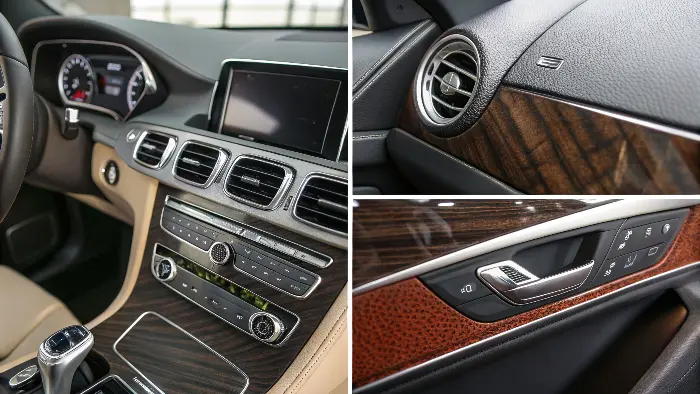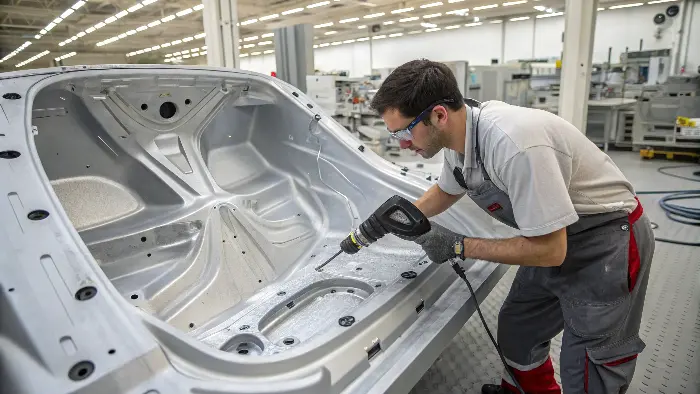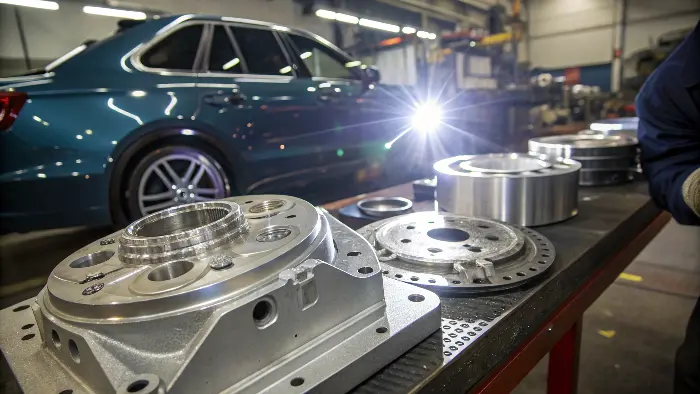Imperfect car interiors impacting brand perception? Scratches and flaws on dashboards or consoles cheapen the feel. CKMOLD’s expert polishing ensures every automotive component shines with quality.
CKMOLD drives perfection in automotive interior components by employing specialized multi-stage polishing techniques, selecting optimal mold steels, and meticulously addressing unique part geometries and texture requirements. Our process guarantees flawless surfaces, enhancing both aesthetic appeal and the tactile experience crucial for automotive brands. We focus on durability for high-volume production.
It’s one thing to say we deliver perfection, but how do we actually do it, especially for something as scrutinized as a car’s interior? I’ve been in this business a long time, and let me tell you, automotive clients have some of the highest standards – and rightly so! The feel of a button, the sheen on a trim piece, it all adds up to the perceived quality of the vehicle. It’s not just about making things shiny; it’s about delivering an experience. So, let’s pull back the curtain a bit on our approach, because for business owners like Michael, who are supplying these critical parts, getting this right is non-negotiable.
Why is Flawless Surface Finish So Critical for Automotive Interior Appeal and Functionality?
Seeing minor flaws in a new car’s trim? It’s disappointing, right? These small defects can disproportionately impact the perceived value and quality of the entire vehicle, affecting customer satisfaction and brand reputation. It’s a real headache.
A flawless surface finish is critical for automotive interiors because it directly influences customer perception of quality, enhances tactile experience, and ensures components fit perfectly. It’s not just about looks; it’s about the brand’s promise of excellence.
Think about the first time you sit in a new car. What do you notice? Often, it’s the details – the way the light catches the dashboard, the feel of the center console, the precision of the knobs and buttons. I’ve had countless conversations with automotive designers and engineers, and they all stress the same thing: the interior sells the car as much as the exterior or performance these days.
The "Touch and Feel" Factor
Automotive interiors are highly tactile environments. Drivers and passengers are constantly interacting with surfaces. A cheap-feeling, poorly finished component can make an otherwise great car feel, well, less than premium. A smooth, blemish-free surface, or a perfectly rendered texture, communicates quality and care. For example, a high-gloss "piano black" finish on a center console needs to be absolutely perfect – any swirl mark or pinhole stands out like a sore thumb. Similarly, a grained texture on a door panel needs to feel consistent and authentic.
Brand Perception and Quality Cues
Those little details add up to the overall brand perception. If a luxury car has interior trim pieces with visible flow lines or sink marks (often masked or exacerbated by poor polishing), it undermines the brand’s premium positioning. Conversely, when every component looks and feels meticulously crafted, it reinforces the idea of quality and value. I remember a project where we helped a client elevate the perceived quality of their mid-range model simply by improving the finish on key interior touchpoints. It made a huge difference!
Preventing Assembly Issues and Rattles
Beyond aesthetics, surface finish can also impact functionality. Poorly finished mold surfaces can lead to parts with slight dimensional inaccuracies or flash. These might not seem like big deals, but in a complex assembly like a car interior, they can cause fitment issues, leading to squeaks, rattles, or unsightly gaps. For Michael, ensuring his components integrate seamlessly is vital for his customers, the automotive OEMs. A good polish helps ensure parts come out of the mold exactly as designed.
What Specific Polishing Techniques Do We Employ for Diverse Automotive Interior Textures?
Automotive interiors feature diverse textures, from high gloss to subtle grains. Achieving each perfectly requires more than a one-size-fits-all polish. Incorrect techniques mean parts that don’t match or feel cheap, a real nightmare for any supplier.
We employ specific, multi-stage polishing techniques tailored to each required automotive interior texture, from mirror-like SPI A1 for chrome-look accents to precise VDI or custom graining for tactile surfaces. This ensures consistent and accurate texture replication on every part.

The variety in automotive interiors is amazing, isn’t it? You’ve got super shiny bits, parts that look like brushed aluminum, soft-touch surfaces, and all sorts of grained patterns. Each of these needs a different approach when it comes to polishing the mold. It’s not just about making it smooth; sometimes it’s about preserving or even enhancing a texture.
High-Gloss Finishes (e.g., Piano Black, Chrome-look)
For those ultra-sleek "piano black" finishes or parts designed to mimic chrome, we’re talking about an SPI A1 or A2 level polish. This is mirror-finish territory. It involves a meticulous progression, starting from very fine stones, moving through multiple grades of diamond paper, and finishing with several stages of diamond paste, often down to 1-micron or even finer. The steel has to be top-notch, like S136, and the environment needs to be spotless. One speck of dust can ruin hours of work. I’ve seen our guys spend days on a single small cavity to get it perfect.
Textured Finishes (e.g., Leather Grain, Technical Grains)
Many automotive parts have textures – leather grain on dashboards, technical patterns on door inserts, or even custom-designed grains. Often, these textures are applied to the mold via chemical etching or laser texturing. The polishing work around these textured areas is critical. Before texturing, the surface needs to be polished to a specific VDI (German standard) or SPI C/B level to ensure the texture takes evenly. After texturing, any surrounding areas that need to be glossy must be polished without damaging the delicate texture. This requires incredible skill and often custom-made soft tools.
Matte and Satin Finishes
| Not everything is shiny. Some parts require a matte or satin finish – think of certain buttons, control panels, or low-glare surfaces on the dashboard. These are typically achieved with very fine abrasive blasting (like bead blasting) or sometimes by a very fine paper or stone finish (like an SPI C-1 or D-1). The trick here is uniformity. Any unevenness in the blast or polish will be obvious on the final part. Here’s a quick look at how we approach common automotive needs: |
Interior Component Example | Desired Finish | CKMOLD Polishing Focus |
|---|---|---|---|
| Center Console Trim | Piano Black (High Gloss) | SPI A1, multi-stage diamond, pristine steel (e.g., S136) | |
| Dashboard Top | Leather Grain Texture | Prepare for VDI/etching, protect texture, consistent matte | |
| Air Vent Louvers | Satin Finish | Uniform fine paper/stone or controlled blast, edge precision | |
| Door Panel Inserts | Technical Grain | Careful prep for texture, polishing adjacent smooth areas | |
| Control Knobs/Buttons | High Gloss with Matte | Combination polishing, masking, extreme precision |
It’s this attention to detail for each specific need that sets a quality molder apart.
How Does CKMOLD Tackle the Unique Challenges of Polishing Large or Complex Automotive Molds?
Polishing a huge dashboard mold or one with tiny, intricate details presents big challenges. Unevenness or missed spots can ruin the whole piece, a real worry if you’re Michael trying to supply perfect components. It’s a daunting task where mistakes are costly.
CKMOLD tackles challenges of large or complex automotive molds by combining skilled manual polishing for intricate areas with specialized tools for large surfaces. Our team’s experience ensures uniformity and precision, even on deep ribs or complex curves, delivering consistent quality.

Automotive molds are often a different beast altogether. You can have a mold for a dashboard that’s almost as big as a small car itself! Or, you might have a mold for an intricate switch assembly with tiny, deep features. Both present their own set of headaches for the polishing team.
Maintaining Uniformity on Large Surfaces
Imagine polishing a mold for a full dashboard. Achieving a consistent finish across such a vast, often contoured, surface is incredibly difficult. If one area is slightly shinier or duller than another, it’ll show up on the part and look terrible. We use a combination of techniques here. For the initial stages, we might use large, powered lapping tools to ensure flatness and consistency. But the final stages often still require skilled hands to blend everything seamlessly. It’s about even pressure, consistent direction, and a lot of patience. I remember a project for a large door panel; it took two of our best guys several days just to get the main surface perfectly uniform before texturing.
Precision in Intricate Details
Then you have the opposite challenge: tiny, complex features. Think about air conditioning vents with all their delicate fins, or the surrounds for buttons and screens. These areas are often hard to reach, and it’s easy to over-polish or damage sharp edges. Our technicians use an array of specialized tools – miniature files, shaped wooden sticks with diamond paste, felt bobs on flexible shafts – to get into these nooks and crannies. It’s almost like dental work sometimes! Precision here is paramount.
Handling Deep Ribs and Non-Line-of-Sight Areas
Many automotive parts have deep ribs for structural support or hidden features on the B-side. While these might not be cosmetic A-surfaces, they still often require a decent polish to aid part ejection and prevent sticking. Polishing deep, narrow ribs is tough. You need long, thin stones or files and a good feel for what you’re doing, as you can’t always see the surface directly. Experience really counts here to avoid unevenness or damaging the rib walls. We always try to design molds with draft angles that help, but some features are just inherently tricky.
It’s this blend of broad strokes for big areas and microsurgery for the details that allows us to handle the full spectrum of automotive mold complexity.
What Role Does Steel Selection Play in Achieving Premium Polishes for Automotive Components?
Ever struggled to get that perfect shine, only to blame the polishing process? Often, the real culprit is the mold steel itself. Choosing the wrong steel for automotive components, especially those needing high gloss or fine textures, means fighting an uphill battle for quality.
Mold steel selection is crucial for premium automotive polishes. High-purity, homogenous steels like S136 or Stavax ESR are vital for achieving flawless high-gloss or intricate textures, as they minimize defects like pits and streaks during polishing.

I always tell my clients, especially those in demanding sectors like automotive, that the foundation of a great mold is great steel. You can have the best polishers in the world, but if the steel isn’t up to the task, you’ll never achieve that flawless finish consistently. It’s like trying to build a skyscraper on shaky ground.
Steels for High-Gloss Finishes
For those stunning "piano black" or chrome-effect interior parts, you absolutely need top-tier steel. We almost always recommend stainless, corrosion-resistant steels like S136 (or its equivalents like Stavax ESR). These steels can be hardened to a high level (typically 50-54 HRC) which helps them take an incredible polish. More importantly, they are manufactured to be exceptionally clean – meaning very few non-metallic inclusions. These inclusions are tiny impurities that can get dislodged during polishing, leaving behind pits or streaks, which are absolute killers for a mirror finish. The ESR (Electro-Slag Remelting) process further refines these steels, making them incredibly homogenous.
Steels for Textured and General-Purpose Surfaces
Not every part needs a mirror shine. For many textured parts or components where a good B-class or C-class finish is sufficient, pre-hardened steels like P20 or NAK80 are common choices. P20 is a workhorse, but its polishability is limited, usually to around an SPI B-2 or B-3. NAK80, being pre-hardened to around 40 HRC and having a very fine grain structure, can actually polish surprisingly well, sometimes up to an A-3 or even A-2 if handled carefully. It’s also great for holding fine texture details. The key is selecting a grade appropriate for the desired texture and the stresses the mold will undergo.
The Critical Importance of Steel Cleanliness and Homogeneity
I can’t stress this enough: for automotive quality, especially anything visual, steel cleanliness is paramount. Any inherent material defect – a tiny pocket of impurities, a slight variation in hardness – will be magnified by the polishing process. This is why we work closely with reputable steel suppliers and often specify ESR grades for critical applications. It might add a bit to the initial mold cost, but for someone like Michael, the reduction in part defects, easier polishing, and longer mold life more than justify it. It’s about thinking long-term.
Making the right steel choice upfront saves so much grief down the line. It’s a cornerstone of our philosophy for producing high-quality automotive molds.
How Do Our Polishing Standards Ensure Consistency and Durability for High-Volume Automotive Production?
Worried about part-to-part variations in finish over a long production run? Inconsistent polishing can lead to assembly line headaches and rejected batches, especially in the demanding automotive sector where volumes are huge and every part needs to be perfect.
Our strict polishing standards, including detailed SOPs, in-process checks, and final gloss measurements, ensure remarkable consistency across high-volume automotive production runs. This meticulous approach also enhances mold surface durability, extending its operational life.

In the automotive world, consistency is king. If Michael is supplying thousands, or even hundreds of thousands, of a particular interior component, each one needs to look and feel identical to the last. And the mold itself needs to hold up to that high-volume production without the finish degrading prematurely. This is where robust polishing standards and processes come into play. It’s not just about getting one part right; it’s about getting every part right.
Standard Operating Procedures (SOPs) for Polishing
We don’t leave things to chance. For every type of finish and every common steel, we have Standard Operating Procedures (SOPs) for our polishing department. These SOPs detail the sequence of abrasives (stones, papers, diamond pastes), the recommended tools, the polishing direction, and critical parameters to watch out for. This ensures that different technicians, or the same technician on different days, can achieve a comparable result. I believe in empowering my team with clear guidelines.
In-Process Quality Checks and Final Inspection
Polishing isn’t just a final step; quality is built in throughout. Our team leaders and polishers conduct in-process checks at various stages. For example, after each major grit change, the surface is inspected for any remaining scratches from the previous stage. We use specialized lighting and magnification. For high-gloss finishes, we might use gloss meters to quantify the shine and ensure it meets the specified range. Final inspection is, of course, rigorous, often comparing the mold surface to approved master samples or boundary samples agreed with the client.
Maintaining Polish Quality Over Mold Life
A great polish also contributes to the mold’s durability. A super-smooth, defect-free surface is less prone to wear from abrasive plastics and can be easier to clean. However, all polishes will eventually degrade with use. Part of our service is advising on proper mold maintenance to preserve the finish. For very high-volume tools, we might also plan for periodic re-polishing as part of a maintenance schedule. This proactive approach helps someone like Michael avoid unexpected production stoppages or quality dips.
It’s this disciplined, systematic approach that allows us to deliver the consistency and durability that the automotive industry demands. It’s peace of mind for our clients.
Conclusion
CKMOLD’s dedicated automotive polishing solutions ensure every interior component we help create meets the highest standards of beauty, feel, and durability. Trust us to perfect your parts, every time, because your success is our driving force.
